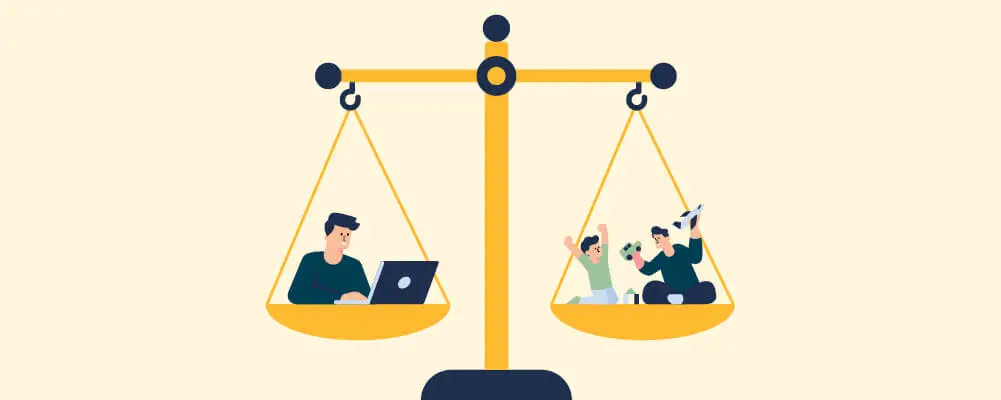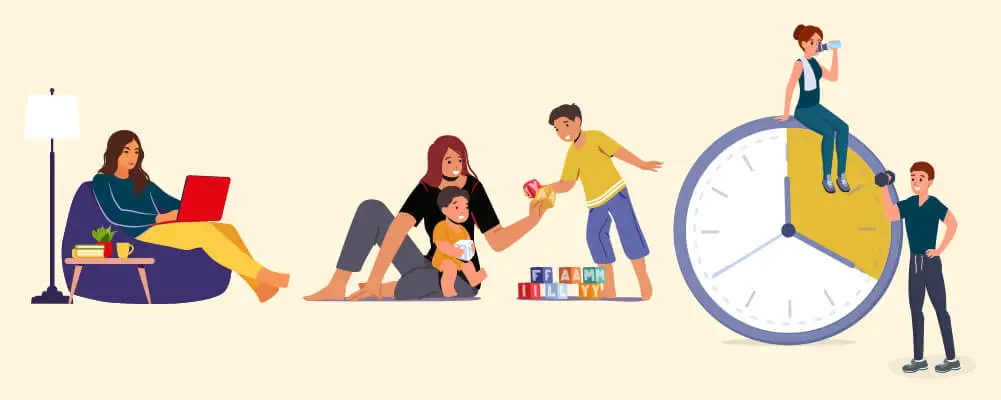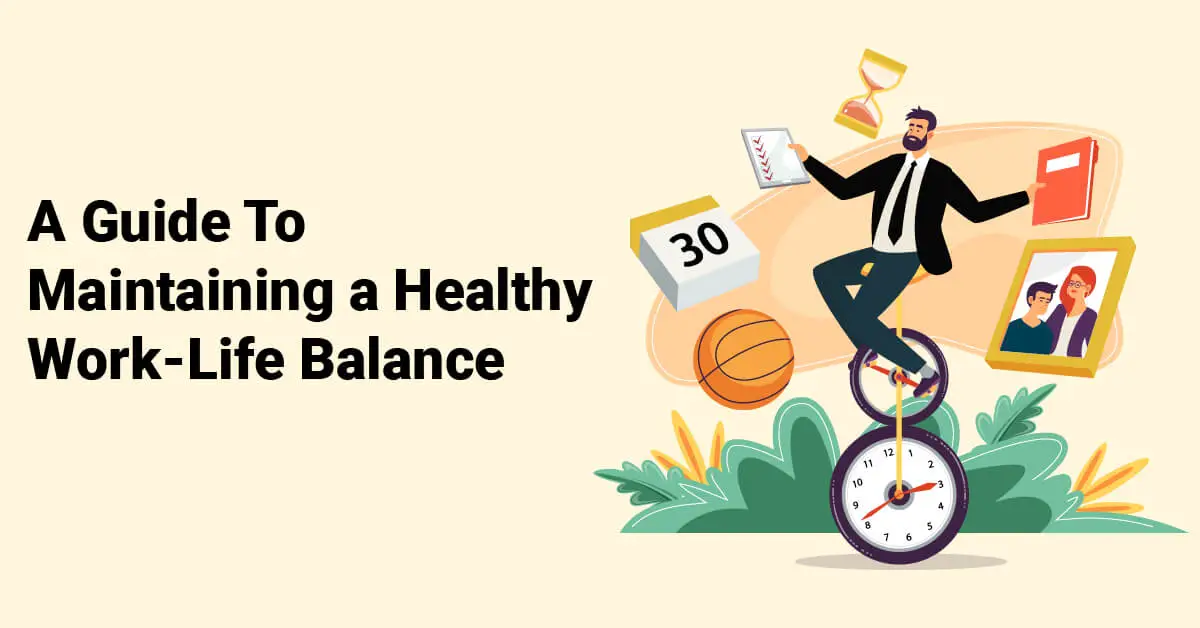Introduction

Maintaining a healthy work-life balance can be tough, especially when you have children at home. If you’re running your own business or working from home in other capacities, you may have struggled to establish a point where work ends and your home life begins. I’m here to help, whether you have a demanding job, home life, or both because there are always ways you can balance the two and make the best of your situation.
In this guide, I take you through establishing and maintaining a healthy work-life balance. By putting my advice into practice, you should be more productive at work and even more comfortable when you’re at home. I’ve split the guide into four main sections that should cover everything you need to know:
- What Is Work-Life Balance?
- Importance And Benefits Of Having A Healthy Work-Life Balance
- Tips To Maintain Or Regain A Healthy Work-Life Balance
- Benefits Of This To Employers
Here I will help you understand why getting a healthy work-life balance is ideal, no matter if you’re an employer or an employee. Since we are dealing with human nature, there’s some mental health information here, so I’ve provided links as references to some of the ideas I touch upon. It also allows you to see that I’m sourcing verified, factually accurate information.
Table of contents
What Is Work-Life Balance?

Maybe you’re totally new to the idea of a work-life balance, in which case you’ll need to know what it is! You’re going to have trouble establishing a work-life balance if you don’t even know what it looks like, after all. In a sense it’s exactly what it sounds like, your work is properly balanced with other aspects of your life.
Cambridge Dictionary’s definition explains it more specifically – ‘the amount of time you spend doing your job compared to the amount of time you spend with your family and doing the things you enjoy.’
Does the amount of time need to be equal to be balanced? Not necessarily, it’s all about what works for you and certain career paths will demand more from you than others. I talk about business owners a lot on this site and running a business is demanding work! What’s important is that you’re not overworking and that your home life isn’t suffering due to your work.
So, what does work-life balance look like?
What Does It Look Like?
Sometimes it’s hard to sit back and recognize when certain things are going well for you. A work-life balance can be one of those situations where you only notice it when something is wrong. Only after we’ve lost a work-life balance do we understand how important it is, and how crippling it can be to not have one.
Three general indicators demonstrate a great work-life balance, no matter your country, culture, or career.
- You succeed at work but have time for social relationships afterward.
- You have ample time to eat, sleep, and take care of other needs.
- You’re not constantly thinking about work when you’re at home.
If that’s your life right now then congratulations, you’re doing well!
Even if you have a decent work-life balance right now, you can still learn how to maintain it from this guide. You can still have other work-related issues that encroach into your life too, which some of my tips can help solve.
Likewise, I have many tips and tricks below that will help those who can’t do some of those things. To have a good work-life balance, remember that it’s ideal for you to have all three. Everybody’s ideal work-life balance will be slightly different, especially since they may need to work with a demanding work schedule, physical/mental health difficulties, or caring responsibilities for children.
Some who have a poor work-life balance are still functional. They can hold down their job and squeeze in time for social relations, often by doing the bare minimum in both. It can be difficult to see issues with your behavior if you’re benefiting from them in some way, like still getting your paycheck, but you can have much more free time if you distinguish work from the rest of your life.
Unsure if your work-life balance is off-kilter? Try the following:
- Take a moment to meditate. Many of the negatives of a poor work-life balance are associated with your mental health. Are you experiencing stress? Does that stress affect your life? Are you happy with your priorities in life or do you see them as a necessary evil? Are you missing out on things, and do you fear missing out on things, because of work?
- Answer those questions, write them down if that helps, and consider how each one makes you feel. Are you satisfied with your answers to most or all of the questions?
- If not, you should now think about finding new priorities. These will help lead the changes that you want to make in your work-life habits. A great place to start is your working hours. If you’re taking on more than you need to be, is that worth losing out on social time? If you’re struggling to meet commissions or deadlines, why aren’t you getting that done in work hours?
- Figure out your alternatives. If there is flexibility at your work, maybe some changes to your working hours can help, or you can try for a new job role within the same company. If your employer isn’t interested in negotiations, you may need to change your own habits to fit the role, or you may want to find a new job that’s more compatible with your needs.
- Once you figure out what you need to do, you should act! Some of those with poor work-life balances know what’s wrong but they aren’t motivated to act on them. Paralysis by analysis is real, so it’s important to stop thinking and start doing stuff at some point.
Maybe you still need some convincing, which is why my next section explains why this balance is important and the many benefits you can reap once you establish that balance.
Importance And Benefits Of Having A Healthy Work-Life Balance

To some, the benefits of a healthy work-life balance are self-evident. To others, however, they may not know that a poor work-life balance is the source of the problems they’re having. As I said, many of the negatives associated with a poor work-life balance are related to our mental health, which can make diagnosing problems and finding solutions more difficult.
So, with that in mind, let’s talk about why maintaining a positive work-life balance is important. The best way to do this is to explain the many benefits that such a balance can bring you.
Avoid Burning Out
One of the biggest advantages of a healthy work-life balance is that you can avoid burnout. Burning out is a very specific type of work-related stress that takes a physical and mental toll on the body while feeling like you’re losing time, losing your identity, or not going anywhere in life. Here’s a quick read of the symptoms of burnout:
- You have trouble getting started at work and concentrating on your workload.
- Becoming cynical about the purpose or results of your work.
- Becoming irritable with coworkers and clients.
- Not feeling any satisfaction, even when you achieve something.
- Disillusioned over your future at your job.
- Drastic changes in your sleep habits, usually by sleeping less.
- Developing addictive behaviors to alleviate stress or numb feelings, from food to drugs.
- Physical stress-related symptoms, particularly with the stomach/bowels.
Even if you’re doing well now, you may face burnout in the future if your work isn’t balanced with your life. Burnout is often categorized into five stages, check them out:
- Honeymoon Phase: Many workers start with positive sentiments and ambitions toward their workplace. This is natural but it’s not representative of your actual attitude toward the job. Every job has a honeymoon stage that’s typically the first few weeks at work.
If you never leave this stage, you may have found the perfect job. Otherwise, having certain positive habits and maintaining a work-life balance can keep you in this stage for longer and stop you from going through the other burnout steps. - Stress Mounts: As you settle into the job, the stress starts to mount and the balancing act becomes more and more crucial to your success. This is where you may notice work activities becoming more taxing, some days are more stressful but you can cope with most hardships.
- Chronic Stress: When those days of stress start to outnumber the less stressful days, you’re entering the chronic stress stage. This is where the symptoms of the last stage intensify and become more noticeable, to both you and those around you. Your initial enthusiasm has gone and you feel like you’re running on an empty fuel tank. You might not realize it’s work that’s the problem yet, so you try to blame other circumstances or even blame other people in your life.
- Burnout Crisis: This is the burnout, the make-or-break moment where you’ll either hit the ground and lose your job or you’ll accept your unhealthy working conditions. This is a personal crisis where you’re at your emotional (and sometimes physical) limit, presenting with chronic symptoms like an overwhelming sense of losing control and becoming detached from yourself and everybody around you. At this stage, you should get help or get out.
- Habitual Burnout: If you last beyond step 4, you’ll graduate to a habitual burnout where you keep up the work and the symptoms continue. It becomes embedded into your personal life and can cause the development of long-term mental illnesses that can’t be shaken by quitting. Those in chronic burnout may experience steps 2 to 4 in cycles, too.
Reduce Stress
As I’ve alluded to several times now, maintaining a great work-life balance is ideal for reducing stress. Not only will an established work-life balance stop you from becoming stressed in the first place, but it will also give you more of those moments where you can relax and alleviate any stress you may be feeling. That means you can still work a job that’s naturally demanding or stressful but, with a proper balance, you can avoid becoming overwhelmed.
Reducing stress may sound trivial but it’s actually very important. The science is clear on what prolonged stress does to a person and it isn’t good. There’s a reason we call it the silent killer, after all.
Achieve Both Career And Personal Goals
Even if you love your job, you’re working for money. We can then use that money to get goods and services and other resources that make our personal lives easier. It takes cash to get a home or start a family, so you need to work to satisfy your personal goals. Many people forget that your personal goals also support your career, which is where burnout takes hold.
With a work-life balance, you won’t have to prioritize one over the other. You’ll be in a good position to do good work and advance in your chosen career, which can then award you the time and the resources that allow you to pursue personal goals. This allows you to get a new car, a new home, get married, maybe have kids, all of those things that enrich your life. This, in turn, motivates you to work so that you can keep enjoying your fulfilling personal life.
I cover working parents a lot and, when you have kids to raise, you’ll need to have your work balanced so you have more time to act as a mother/father. That brings us to the next advantage…
Having Time For Friends And Family
We only have one life and we shouldn’t spend all of it working. That’s why one of the best benefits of a work-life balance is having time for your social connections. When you have friends and a family, you need to spend time with them to cultivate those relationships and enjoy your time together.
Your most precious memories won’t be those you created at work; they’ll be those you created while spending time with the ones you love. If your work is getting in the way of your social relations, you need to reassess your priorities and find a way to stop that, even if it means leaving your current job for one that’s more suitable.
Even worse, overbearing work can get in the way of your ability to be a parent. Balancing your work with your parental responsibilities is essential to being a good influence in your children’s lives. Remember that your kids are always learning by example, so you don’t want them to inherit stress-inducing or toxic attitudes toward work from you and the way you manage your time.
If your work-life balance is askew and you’d like to experience any of these benefits, you should check out my tips below. These can help you establish, regain, or maintain a healthy balance between your job and the rest of your life.
Tips To Maintain Or Regain A Healthy Work-Life Balance

Now that we know what a work-life balance is and how establishing one can benefit your life, it’s time to look at how you make that balance happen. Whether you’re starting out, trying to regain a balance that you lost, or you’re trying to maintain the balance you have, I have seven tips right here that’ll help.
Creating Boundaries Between Work And Non-Work Activities
To establish the work-life balance, you first need to distinguish work from non-work activities. That may sound simple but, if you have barriers between work and life, you wouldn’t be here looking for help!
The surest way to set these boundaries is by having a working day. This is often in eight-hour blocks but this depends on your job role and which field you work in. Assuming you have kids, you’ll also need to work around those responsibilities, such as preparing them for school.
Have a clear schedule where you put your hours in and then leave without doing overtime. Yes, this also means you shouldn’t check emails and other work communications during your time off.
Adding Exercise Into Your Lifestyle
The perfect way to carve out some time and forget about your work troubles is to get an exercise routine. I’m sure I don’t need to convince you of the many benefits of exercise but, in a work-life balance context, it gets you away from your work (or home office) and gives you something else to do. It can help relieve stress from your home life too, especially if your kids get you stressed out sometimes.
The endorphins released during exercise will give you a sense of accomplishment and build yourself outside of work, so you’re working towards your personal life instead of your professional life. The intensity of this exercise can vary since you may get physical activity during your work, what matters is that you set aside time to hone your body and mind, away from a workshop or an office chair.
Setting Time Aside For Certain Activities
Alongside getting some exercise, you should also set aside time for other activities. Taking time to practice a hobby will have many of the mental advantages of exercising, such as that feeling of accomplishment. If your hobby involves physical activity, it’ll confer a lot of the same physical benefits too. It just makes sense that you need to set aside time to perform non-work activities that you enjoy. If they further a hobby or a personal goal unrelated to your work, even better!
Some who are employed but unhappy with their jobs have even started a hobby and then monetized it. This can act as a side income, furthering your personal life goals, and it can even out-earn your job and take priority. If that happens, you can act as your own boss and work at your own pace, which can help create a work-life balance.
Not everybody can monetize hobbies, however, so this isn’t something anybody should rely on. Also, as I’ve already said, running your own business is a lot of work! Workaholic parents may feel the temptation to take on as much work as possible but you should always try to maintain a balance between your job and your family.
Learning To Say No To Things Like Overtime
If you’re working overtime and it’s harming your life, you should stop. Whether it’s because the money is good or you genuinely love your work, sometimes you need to let go and stop taking every hour that you can. By letting go of overtime, you can spend that time somewhere else, with other people, doing things that you enjoy. If you own a business, this is easier because you’re your own boss.
You can still take overtime occasionally once you’ve established these boundaries, to get the benefits that overtime can get you. However, if you are employed and can’t say no for whatever reason, you need to learn ASAP. Remember that you don’t owe your employers any overtime and that you are perfectly within your right to refuse it if they try pressuring you.
Learning To Work Smart, Not Long
This tip may be incredibly context-specific but, in certain job roles, this can be exactly what you need. You should work smart, not long. Don’t worry, this doesn’t mean you should cut corners or rush your work. Instead, try to take stock of your tasks and go for the most important ones.
By completing the most important tasks first, preferably within a timed block, you’ll seem more productive and you won’t have to carry these larger tasks into your home life. In the worst-case scenario where you do need to pick up some slack at home, it’ll be the unstructured busywork that’s left, which will be quick and less stressful to tackle.
Drawing A Line Between Work And Home
As I mentioned at the start of this guide, working from home makes establishing boundaries difficult. If you’re working at home in a semi-permanent or permanent capacity, you should set up a space where you can work. A home office can help with this but only if you leave that room alone outside of your work hours. If you work outside of your home, like an office that you need to travel to, then it’s much easier to establish an adequate work-life balance.
Here are some examples:
- Turn off work phones outside of work and sign out of work management apps.
- Let your employers/employees know your policy of when you’ll respond to work-related communications. Your company may have a policy mandating emails need to be responded to within one working day, etc.
- Get a space where you work, away from the distractions of home life.
Limiting Time-Wasting Activities
Having mentioned phones, you should also avoid time-wasting activities that eat up your time. We both know that everybody spends a little too much time looking at their phones nowadays, myself included! In both your personal life and your career, it’s common for smartphones to distract us from the task at hand. If that’s you, you need to limit those activities so you get the most out of both sides of your work-life balance.
Don’t spend too long surfing the Internet at work. This can be tough if you work on the Internet, especially if you’re working at home, but you’ll be more productive if you cut online distractions from your life. Turn off certain notifications and log out of all social media. You can even consult productivity software that helps to keep you on track.
Sometimes people are the problem too. Whether it’s hyperactive coworkers or your own family, negotiate and communicate with them that you need to be left alone to do your best work.
Some misidentify these reactions as being selfish. If this seems selfish to you, remember that this is about taking care of your needs and making sure you have a healthy work-life divide. Once you’ve achieved that, you can be as selfless with your free time as you want, but you don’t owe anybody time if it stands in the way of self-improvement.
If the problematic family members are children, you can still find ways to negotiate with them but you shouldn’t be as assertive. Instead, keep your work schedule flexible enough that you can deal with any problems your kids are facing.
Keep Track Of Weekly And Monthly Working Hours
Quantifying and visualizing your time is a great way to track your worked hours… for some. This can depend on how you work under pressure and other intuitions that you have. Things that work for me may not work for you, but there’s no harm in trying.
For example, some of us excel when placed under a tracker while others will buckle under the expectations placed upon them. With that in mind, try counting your hours and see how it works out for you!
By counting how many hours you work across the week, and then the month, you can see how your work performance trends. This means you can identify if you’re working more or fewer hours than last week. Your goal will be to lower those times until you’re at a comfortable work-life balance that works best for you.
If you’re experiencing work-related stress, you should also count hours that are spent thinking about work. You can count them among hours worked or create your own counter for non-work stress, either way, this creates a representation of that stress that you can then work towards beating.

You may be interested in my other Working Parent articles:
5 Things You Need To Know Before Going Back To Work After A Baby
Benefits Of This To Employers

Maybe you’re worried about upsetting your employer if you follow some of the things recommended in this guide. Maybe you’re an employer who wants to know how a work-life balance can benefit your business. Whichever you may be, this section has you covered.
There are three main identifiable benefits to every business whose employees practice a work-life balance. These are broad enough to translate to most industries, so hopefully, I’ve covered yours here!
Happier Workforce
A workforce of individuals with healthy work-life balances will be much happier at the company. This means they’ll stay away from that burnout cycle that I covered above and so they’re more likely to stick around. They’ll stay with the company for longer, providing more labor and allowing the employer to source skilled, familiar faces for promotions instead of taking in new people.
A happy workforce also acts as a great recruitment and advertising tool. By speaking to others about how happy they are, the workforce can unwittingly generate good PR for your business based on how they treat their employees. This will attract like-minded workers who will be a good fit for the goals and culture of your company, making recruitment easier for some industries.
More Productivity
A happier workforce that has a great work-life balance will also be more productive. A miserable workforce will drag their feet when working and they’ll shed employees as they leave the company, causing halts in productivity as new hires are brought in, trained, and begin the cycle again. This costs employers both time and money, so they should try to avoid that at all costs. They avoid those pauses and other troublesome disruptions when the workers have a good work-life balance.
Similarly, the workers will be more productive because they have set working schedules. Their work-life balance will enable them to get into “the zone” so they can be hyper-productive during the day, knowing that they have a balanced and fulfilling life to return to when they are done. You don’t get this with overworked or undisciplined workers who will work sporadically and won’t have a focused timeframe where they put in good work.
Flexible Working Opportunities Attract Good Candidates
As I covered above, sometimes the employer needs to negotiate and offer incentives to help an employee achieve a good work-life balance. Those situations don’t need to be at the expense of the business, it can actually be a good thing. By providing flexible working opportunities, it’s possible to outcompete other employers since the business is a better place to work at.
Businesses that embrace a work-life balance in their corporate culture can then use it as a selling point to attract the best candidates to a job role. Employers won’t just have the pick of the best and most qualified candidates for the role, they’ll also reap the other benefits of a work-life balance as detailed above.
Summary

With that, you’ve come to the end of my guide on maintaining a healthy work-life balance. After reading it all, you should now know what a work-life balance is and what it looks like, the benefits of a work-life balance, and then the tips and tricks that enable you to put that balance into place. For employers, I’ve also explained how businesses benefit from work-life balances too, not just individual workers.
By following the information I’ve organized above, you can hopefully drive a wedge between your career and your downtime, so that you enjoy both. Before I let you go, you must remember that changing life habits can be difficult. It’s a process that may take multiple attempts, so start with small changes and work from there. Use this guide as a checklist if that helps. Building positive habits in your professional and personal lives is the key to establishing a productive work-life balance. Remember that those habits tend to stick after approximately 30 days, in my experience, though it varies for everybody.


3 comments
Comments are closed.